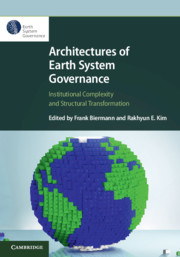Book contents
- Architectures of Earth System Governance
- Series page
- Architectures of Earth System Governance
- Copyright page
- Contents
- Contributors
- Acknowledgements
- 1 Architectures of Earth System Governance
- Part I The Building Blocks
- Part II Core Structural Features
- Part III Policy Responses
- Part IV Future Directions
- 14 Taking Stock and Moving Forward
- Glossary
- Index
- References
14 - Taking Stock and Moving Forward
from Part IV - Future Directions
Published online by Cambridge University Press: 17 April 2020
- Architectures of Earth System Governance
- Series page
- Architectures of Earth System Governance
- Copyright page
- Contents
- Contributors
- Acknowledgements
- 1 Architectures of Earth System Governance
- Part I The Building Blocks
- Part II Core Structural Features
- Part III Policy Responses
- Part IV Future Directions
- 14 Taking Stock and Moving Forward
- Glossary
- Index
- References
Summary
There is a growing consensus in the literature that governance architectures matter. However, we lack sufficient knowledge about their emergence, dynamics and impacts. This concluding chapter summarizes all insights in the book Architectures of Earth System Governance, and emphasizes how this book has made a scientific contribution by enhancing conceptual clarity, synthesizing a decade of intense research, and charting directions for future research. The book has made at least one point clear: the ‘architecture lens’ offers a bird’s-eye view on the global governance landscape that is highly valuable in explaining outcomes of world politics. The architectures matter in how institutions interact with others, how institutions are entangled with others in larger regime complexes and how institutions are affected by broader architectures that are more or less fragmented or polycentric. In this concluding chapter, we also illustrate how such key insights gained could inform a set of transformative policy proposals regarding the architecture of earth system governance.
Keywords
- Type
- Chapter
- Information
- Architectures of Earth System GovernanceInstitutional Complexity and Structural Transformation, pp. 299 - 321Publisher: Cambridge University PressPrint publication year: 2020
References
- 2
- Cited by

